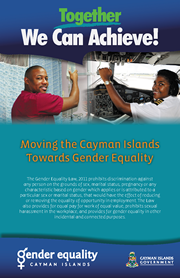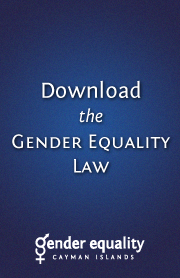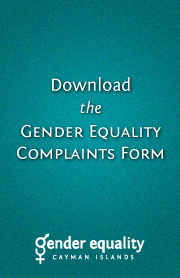In the Cayman Islands, the 2010 Census of Population and Housing reported that females earned an average of CI$7,355 less than males per year, a difference of almost 17%.
Income gap by sex

The income gap was even wider among Non-Caymanians, with Non-Caymanian females earning three quarters of what Non-Caymanian males earned, an average of CI$10,073 less per year.
Income gap by sex and status

At every education level females also earned less than males. The gender gap was widest for those with a university degree.
Income gap by sex and education level

Females earned less than males in all occupational groups except for customer support workers and agricultural workers. For every $1.00 that a male employed in an elementary occupation earned, a female in the same occupational category earned 64¢. Female service and sales workers earned 72¢ for every $1.00 that their male co-workers earned.
Income gap by sex and occupation

The reasons for the large and consistent differences in average income of working men and women almost certainly include various elements of indirect and structural discrimination that people often don't consider as well as unfortunate - and legally prohibited - cases of direct discrimination on the basis of sex and/or gender.
Direct discrimination can occur when men and women have different levels of compensation for the same work or when they have different job requirements for the same pay level. The discrepancy in remuneration or job requirements may be the result of the individual's sex or of his or her gender characteristics.
Indirect discrimination and structural discrimination are even more complicated. Indirect discrimination occurs when an act, practice or policy is applied to everyone but affects males and females differently, disadvantaging or advantaging one group. Structural discrimination can result from a number of different factors and relates to how our society is organised and what we value.
For example, jobs traditionally associated with men tend to pay better than traditionally female jobs for the same level of skill required and irrespective of the level of qualification. And women are more likely to work part-time, more likely to take parental leave and less likely to work overtime due to the unequal burden of child care, elder care and domestic work. Gender bias in skills and personal qualities also affect career choice, compensation and progression.
Some of the factors that contribute to the income gap are seen as “choices”, but becoming a parent is an example of a choice that often has different outcomes for men and women. Choices of college major or career path might not always be freely made because of societal pressure and stereotypes or different opportunities given to girls and boys.
All of these factors and more mean that females do not have the same opportunities as males to participate in the paid economy and to earn income.
Taking an in-depth look at gender gaps, income inequality
This article in the Caymanian Compass gives an overview of income gaps between males and females in the Cayman Islands, including the reasons that they have developed, the ways in which they have changed over the years and how we can promote greater equality between the sexes.
The Vicious Cycle of the Gender Pay Gap
An article from the the online research and business analysis journal of the Wharton School of the University of Pennsylvania. It describes how the gender pay gap is a labyrinth of unconscious prejudice and blatant discrimination, a byproduct of unbalanced professional opportunities, educational prospects and deeply-entrenched societal norms. With so many forces at work, getting to the root of glass ceiling issues within a single firm or industry is difficult, if not impossible.
Pay Equity Now!
This campaign from Education International, a global federation of organisations of teachers and other education employees, affirms the right of workers to equitable wages and focuses on the education sector in particular. Background articles have been produced that examine gender pay gaps, including a comprehensive one on the reasons and implications for society as a whole.
The Simple Truth About the Pay Gap
This brief publication from the American Association of University Women explains the pay gap in the United States and presents new ideas of what can be done about it. Many of the explanations for this inequality and strategies to promote greater gender equality are also relevant in the Cayman Islands.
Explaining the Gender Wage Gap
This article from the Centre from American Progress analyses the gender wage gap in the United States of America and explains why the structural barriers to women's progress and enduring social attitudes about women's place contribute the most to women's lower pay. Understanding these constraints and what causes the gender wage gap is an important first step to change structural barriers.



